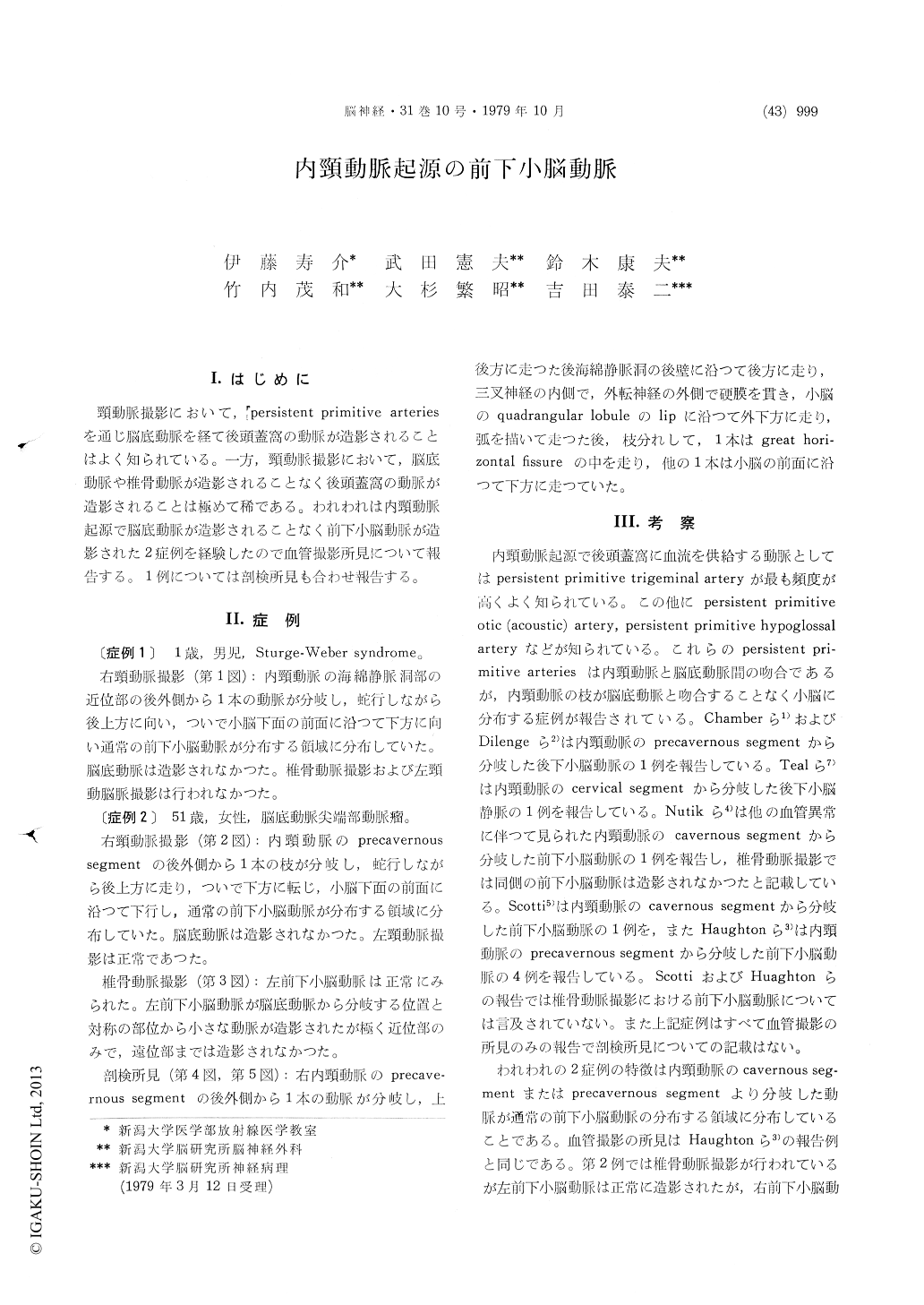Japanese
English
- 有料閲覧
- Abstract 文献概要
- 1ページ目 Look Inside
Ⅰ.はじめに
頸動脈撮影において,persistent primitive arteriesを通じ脳底動脈を経て後頭蓋窩の動脈が造影されることはよく知られている。一方,頸動脈撮影において,脳底動脈や椎骨動脈が造影されることなく後頭蓋窩の動脈が造影されることは極めて稀である。われわれは内頸動脈起源で脳底動脈が造影されることなく前下小脳動脈が造影された2症例を経験したので血管撮影所見について報告する。1例については剖検所見も合わせ報告する。
Two cases of the anterior inferior cerebellar ateries which originate from the cavernous and precavernous segments of the internal carotid artery are reported. Case 1. One-year-old boy with Sturge-Weber syndrome. Right carotid angiography revealed that an aberrant artery originated from the posterolateral aspect of the porximal portion of the cavernous segment of the internal carotid artery. It ran inferolaterally over the anterior aspect of the inferior surface of the cerebellum down to the biventral lobule. Vertebral angio-graphy was not performed. Case 2. 51-year-old female with an aneurysm of the tip of the basilar artery. Right carotid angiography disclosed that an aberrant artery arose from the posterolateral aspect of the precavernous segment of the internal carotid artery. It ran posteriorly, then inferolaterally over the anterior aspect of the inferior surface of the cerebellum down to the biventral lobule. A branch advanced posteriorly in the great horizontalfissure. Vertebral angiography showed that the left anterior inferior cerebellar artery was normal in origin, course and size. A fine twig arose from the basilar artery opposite to the origin of the left ante-rior inferior cerebellar artery. Autopsy specimen disclosed that an aberrant artery originating from the posterolateral aspect of the precavernous segme-nt of the internal carotid artery entered the posterior cranial fossa piercing the dura mater a little medial to the trigeminal nerve. It ran between the trigemin-al and acoustic nerves and advanced laterally along the lip of the quadrangular lobule. At the great horizontal fissure it divided into two branches : one passed posterolaterally in the great horizontal fis-sure ; another ran down over the biventral lobule. Scotti reported one case of the anterior inferior cerebellar artery which originated from the cav-ernous segment of the internal carotid artery. Haughton et al. reported four cases of the anterior inferior cerebellar artery which arose from the precavernous segment of the internal carotid artery. They did not referred to findings on vertebral angiography in these cases. Also autopsy findings have not been presented so far. Haughton et al. postulated that persistence of the primitive trige-minal artery with incomplete fusion of the longi-tudinal neural arteries might result in an anterior inferior cerebellar artery arising anomalously from the cavernous internal carotid artery. Each of our cases had either a branch to the biventral lobule or a branch to the great horizontal fissure. These branches normally arise from the anterior inferior cerebellar artery. It is concluded that these aberrant arteries should be the anterior inferior cerebellar artery originating from the precavernous segment of the internal carotid artery and embryologically this anomaly should be a variant of the persistent primitive trigeminal artery.

Copyright © 1979, Igaku-Shoin Ltd. All rights reserved.


